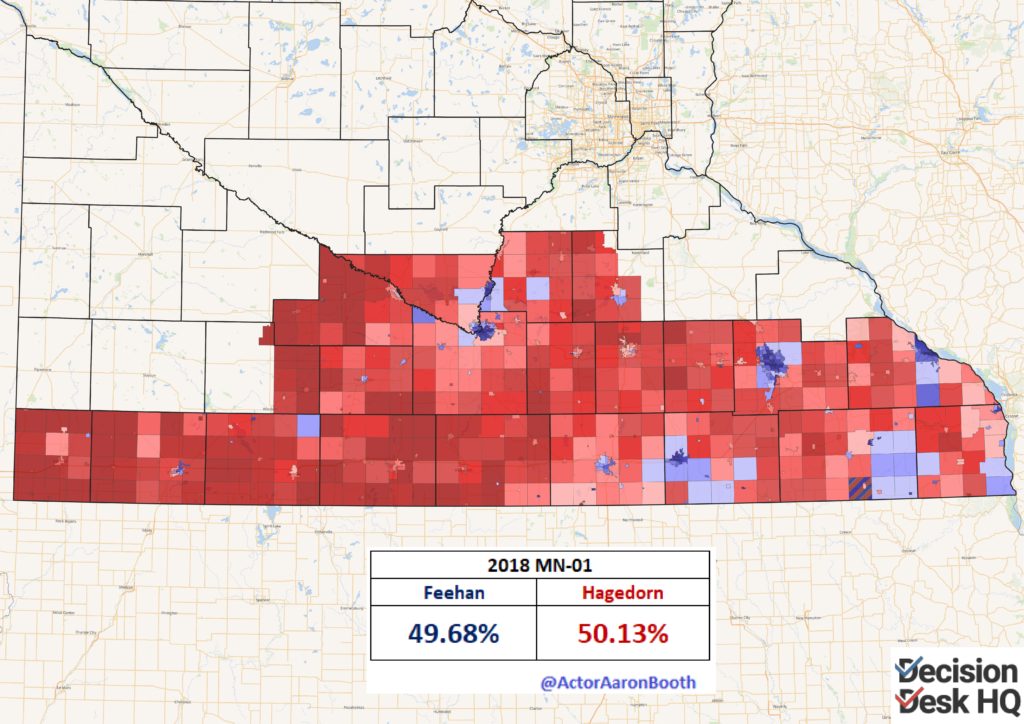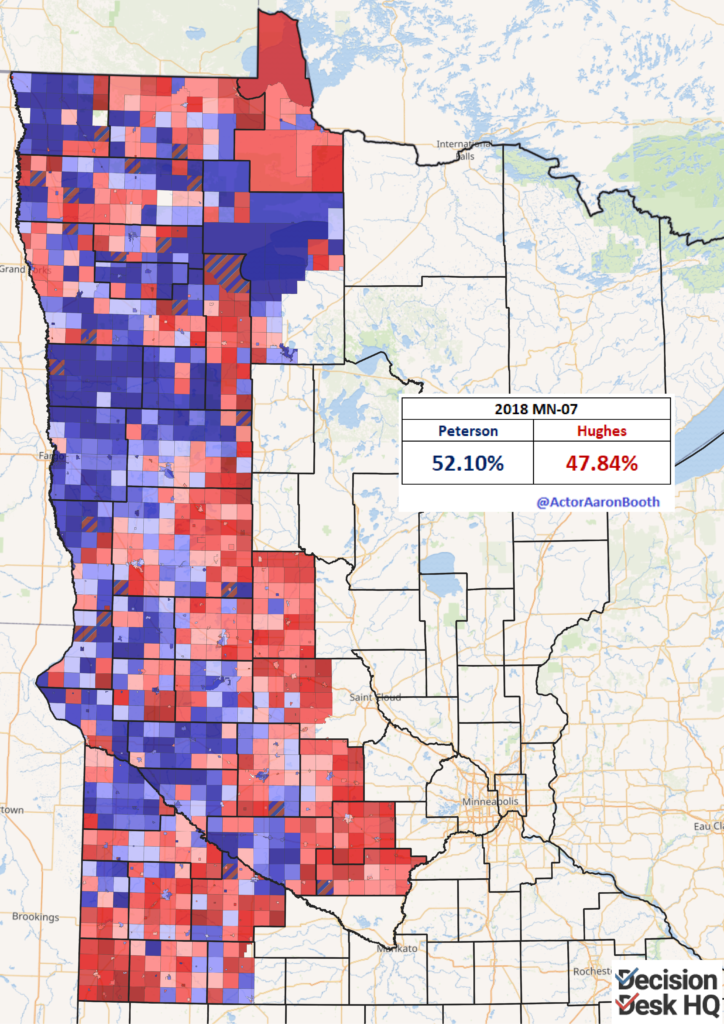In 2020, Minnesota will be home to at least a few high profile Congressional races. With Democrats likely to keep the House, both the DFL and GOP to move the margin by flipping a seat or two. Two of the seats which flipped in 2018 (MN-03 and MN-08) are highly unlikely to be competitive in 2020 and could very well be in landslide territory. The three that are generally considered competitive are MN-01, MN-02 and MN-07.
MN-01 (Jim Hagedorn-GOP)


This district stretches across southern Minnesota from South Dakota in the west to Wisconsin in the east. This is the only district in the state of Minnesota to share a land border with more than one other state in the union. 2020 features a rematch between Republican incumbent Jim Hagedorn and DFL nominee Dan Feehan.
Feehan has proven himself to be a solid fundraiser. As of the most recent FEC filing, Feehan lead Hagedorn in cash on hand $1.78 million to $950 thousand. Outside of the 7th, the 1st is likely to attract the most outside spending.
Hagedorn has faced some scandal including a recent one involving constituent mail. There have also been questions about whether Hagedorn resides at his address in the 1st district (at which he is registered to vote) in Blue Earth or in the 5th district where his wife (the state Republican Party Chair) is registered to vote in Saint Louis Park. Residency is certainly not a requirement though it is unknown where that will become an issue in this race. Lewis in 2016 and Bachmann in 2012 were both elected to districts in which they did not live.
The first district contains many rural farming and manufacturing communities that are likely to vote for Trump again in 2020. The DFL does see some encouraging signs in Mankato as well as the Rochester metro area that has become increasingly more blue.
MN-01 Keys to Victory
- A Hagedorn victory will involving running up the score everywhere west of Mankato as well as ride potential Trump coattails along the I-90 corridor between Fairmont, Albert Lea and Austin where Trump made significant gains in 2016.
- Feehan‘s path to victory will be to continue to expand his margin in Mankato, Rochester and Winona while holding the cities of Austin and Albert Lea. One municipality Feehan could try to look towards for a few more votes is Worthington in Nobles County. Worthington was home to a significant COVID-19 outbreak earlier this year. One of the main employers in the city is a JBS pork plant and the population has become increasingly Hispanic in recent years through immigration.
MN-02 (Angie Craig-DFL)


Minnesota’s Second Congressional district contains a large portion of the southern Twin Cities suburbs in Scott and Dakota Counties along with a slice of Washington County. The district continues south into some more rural areas. The DFL has some strenghth still in Red Wing as well as a pretty solid hold on Northfield. A significant portion of the vote in Northfield isdriven by St. Olaf and Carleton colleges.
In 2016, Jason Lewis was able to win the district with the help of an Third Party candidate who ran to Craig’s left. In 2018 with a more favorable environment and a two-way race, Craig was able to unseat Lewis. The 2020 match-up is between Congresswoman Craig and Republican Tyler Kistner. Kistner outraised Craig $747 thousand to $730 thousand in the second quarter. In the breif pre-primary filing period in quarter 3, Craig outraised Kistner $217 thousand to $182 thousand. As of the last filing, Craig lead Kistner in cash on hand $2.6 million to $488 thousand.
MN-02 Keys to Victory
- A Craig win is looking reasonably likely at this time. A Craig win would involve continuing to build on recent DFL gains in the cities of Burnsville, Eagan and Apple Valley. She will also need to not lose too much more ground in the more rural portion of the district. The upside for the DFL is that they have room to grow in Savage, Shakopee, Prior Lake and Lakeville.
- A Kistner victory will probabily involve a series of things breaking in his direction. First, he will need Legal Marijuana Now Candidate Adam Weeks to peel away some of the more liberal voters away from Craig. Second, he probabily cannot afford Trump to lose too much ground in the inner-ring suburbs contained in this district. Third, he will likely need to match Trump 2016 margins in the rural portions of the district.
MN-07 (Collin Peterson-DFL)


Potentially the most competitive race may be the 7th Congressional district that covers most of western Minnesota. The district contains very few sizable cities. Rather, it is mainly made up of rural farming communities, Native American reservations and some college campuses. The district has been represented by Congressman Collin Peterson since 1991. In 1990, he defeated incumbent Republican Arlan Stangeland (who had faced a scandal involving several long distance phone calls to a female lobbyist). Peterson had run for the seat unsuccessfully in 1984 and 1986 prior to his 1990 bid. Since 1990, Peterson has won reelection every two years by varying margins. Peterson was able to hold on in the difficult 2010 cycle for the DFL when longtime Congressman Jim Oberstar fell to Chip Cravaack.
In 2020, Peterson faces his strongest opposition since 2014 when he was challenged by State Senator Torrey Westrom. That cycle, the GOP spent more money in the district than they had previously and were able to get Peterson’s margin down into the single-digits. In 2016 and 2018, Peterson’s margins declined further against an underfunded candidate. His 2020 opponent is former State Senator Michelle Fischbach. She was breifly the Leitenant Governor in 2017 replacing Tina Smith, who vacated her office to take an appointment to the United States Senate.
Complicating Peterson’s reelection in 2020 are candidates from Minnesota’s two other major parties: Slater Johnson (Legal Marijuana Now) and Rae Hart Anderson (Grassroots-Legalize Cannabis). While it is unclear how much of the vote those two candidates will take, it is likely that their voters could take more votes away from Peterson in key college towns such as Bemidji, Moorhead and Morris.
MN-07 Keys to Victory
- The key to a Peterson victory in 2020 would have to include further gains in Bemidji, Moorhead and Morris, while keeping any further erosion to a minimum in ancestrally Democratic Kittson, Mahnomen, Norman and Polk counties.
- A Fischbach victory would involve further gains mainly centered in the Twin Cities exurbs while keeping Peterson’s margins down in the Minnesota River Valley and the northwestern portion of the state.
Aaron Booth (@ActorAaronBooth) is a contributor to Decision Desk HQ.